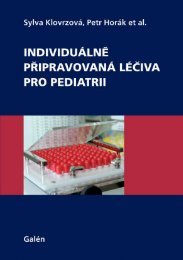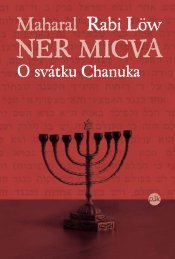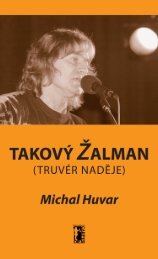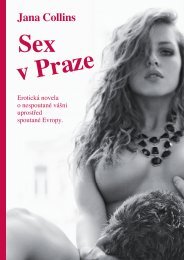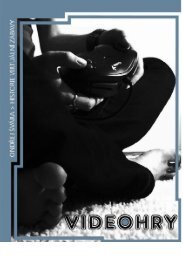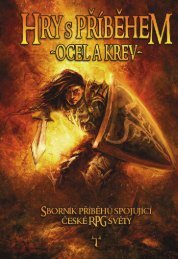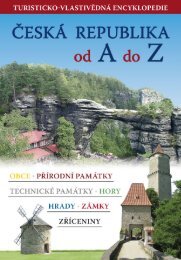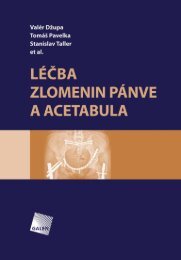ORBIS SENSUALIUM PICTUS - Databook.cz
ORBIS SENSUALIUM PICTUS - Databook.cz
ORBIS SENSUALIUM PICTUS - Databook.cz
Sie wollen auch ein ePaper? Erhöhen Sie die Reichweite Ihrer Titel.
YUMPU macht aus Druck-PDFs automatisch weboptimierte ePaper, die Google liebt.
the second unaltered edition. Its important part isthe postscript by the expert Jiřina Popelová.A two-lingual Latin and German Orbis sensualiumpictus was edited by the publishing house ofthe Czechoslovak Academy of Sciences in 1970 asthe seventeenth part of the great scientific editionof the Works of Jan Amos Komenský (J. A. ComeniiOpera omnia). That critical edition appeared thanksto Jaromír Červenka (the Latin text) and StanislavKrálík (the German text), who based their workon the Nuremberg editions from the years 1659and 1662. The afterword was written by MartaBečková.The non-traditional anthology of Comenius’ Orbissensualium pictus presented is intended to bethe author’s live legacy. That is also why it concernspredominantly the world of human activities. Thismeans that the parts of the work were selectedwhich show most expressly man’s individual activitiesand their results, material and spiritual. It is ouraim to show Orbis’ dynamism as well as how Comeniuswas able to grasp what was fundamental for theindividual activities. Whereas Orbis’ first part sufferedas far as its topicality is concerned, due to theprogress in human knowledge, the chapters showingthe world of human labour have a vivid effect asinteresting documents of the way of life and humaneffort at the time when their author lived, or even inthe times that are much older.LiteratureNaděžda Kvítková• ČAPKOVÁ D.: Dílo Komenského a myšlení 17. století.Filosofický časopis, roč. XXXV, č. 6, 941–949(Comenius’ work and the thinking of the 17 th century.Philosophical Journal, year XXXV, No. 6, pages941–949)• ČAPKOVÁ D.: Některé základní principy pedagogickéhomyšlení Komenského. Rozpravy ČSAV(XXXVII), Praha 1977 (Some fundamental principlesof Comenius’ pedagogic thinking. Discussions ofCzechoslovak Academy of Science (XXXVII), Prague1977)• ČAPKOVÁ D.: Vzdělávaní malých dětí v pojetí univerzálníhoceloživotního vzdělávání v díle J. A. Komenského.Praha/Univerzita 17. listopadu 1971 (Theeducation of little children under the concept of universallifetime education in Comenius’ work. Prague,University of 17 th November, 1971)• FLOSS P.: J. A. Komenský a vědy o přírodě a člověku.Krajský pedagogický ústav Olomouc 1953. (J. A.Comenius on the science of nature and man. Regionalpedagogical institute, Olomouc 1983).• HÁDEK K. : Komunikativní vztahy jako interpretačníhledisko při klasifikaci jazykových jevů. In AUPO,Philologies 55, 1987, s. 91–95 (Communicative relationsas the interpretative view in the classification oflinguistic data. In AUPO, Philologica 55, 1987. pages91–95)• JARNÍK H.: Předmluva k vydání 10. sv. Veškerýchspisů Jana Amose Komenského. Brno 1929 (Forewordto the tenth volume of Collected Comenius’writings. Brno 1929)• PATOČKA J.: Filosofické základy Komenského pedagogiky.In: Komeniologické studie I, Praha, OIKOY-MENH 1997, s. 164-231 (Philosophical foundations ofCormenius’ pedagogy. In: Comeniological studies I,Prague, OIKOYMENH 1997, pages 164–231)• Otázky současné komeniologie. Praha, Academia1939 (Problems of contemporary Comeniology,Prague, Academia 1981)• POPELOVÁ J.: Epilog. In: Orbis sensualium pictus.SPN Praha 1979 (Epilogue. In: Orbis sensualium pictus.SPN Prague 1979)• ŠKARKA A.: Jan Ámos Komenský. In: Dějiny českéliteratury I. Starší česká literatura. Praha 1259 /s. 412-454 (Jan Ámos Comenius. In: History of Czechliterature I. Older Czech literature. Prague 1959, pages412–454)• VESELÝ J.: Komenský jako předchůdce současnéteorie vyučování cizím jazykům. In: Jan Ámos Komenský.Příspěvky z komeniologické konferencepořádané Pedagogickou fakultou v Hradci Královéve dnech 8. – 11. října 1970. SPN Praha 1972, s. 51-54 (Comenius as a predecessor of contemporarytheory of teaching foreign languages. In: Jan ÁmosComenius. Contributions of a conference organizedby the Pedagogical Faculty in Hradec Králové in thedays of 8 th – 11 th October 1970, SPN Prague 1972,pages 51-54)• Vybrané spisy Jana Amose Komenského sv. IV.výbor z Obecné porady o nápravě věcí lidskýcha z věcného pansofického slovníku. SPN Praha 1966.Úvod J. Červenky, s. 16–53. (Selected writings ofJ. A. Comenius. vol. IV. Selected parts of the Generaladvice on the remediation of human matters and ofthe Factual pansophic dictionary. SPN Prague 1966.Foreword by J. Červenka, p. 16–53)Editorial notesA selection from Orbis sensualium pictus, thematicallyrelated to the world of human activities – i.e. 60 chapters,was published by the publishing house TRIZONIAin 1991 as the first edition. It was however being preparedeven before the year 1989, originally for the State PublishingHouse with the aim of being used in teaching foreignlanguages as a supplementary text. It is fully understandablethat there was no interest in teaching Latin at thattime, and that is why the selection was prepared to appearin four living languages only, i.e. in Czech, German, Englishand Russian. For the editorially adapted text therewas however no hope of being edited soon in the StatePublishing House at the time of organizational changes,and so it happened that it was left to a private publisher.The newly adapted and enlarged edition by MA-CHART, the publishing house, was complemented withComenius’ Latin text from the Nuremberg edition, whichhad appeared in a critical edition in ACADEMIA, a publishinghouse, in 1970. Chapters were added characterizingthe ideational bases of their author (God, the world,the senses, virtues and religions). The graphical designis completely new. The Latin text, as the basic text, followsseparately, immediately below the correspondingpictures. The mutations of the text in the living languagesare led by the tendency to correspond to the contemporarymode of expression.That is why the Czech text often differs, particularlyin the word order, from the original Latin version as wellas from the versions of the older Czech translations. Asfar as the Latin text is concerned, a slight restriction isthe usage of improper relative clauses and transitive constructions.In order that the meanings may be clearer itwas sometimes necessary to repeat the subject or expressit with the help of a substantive instead a pronoun.It was only occasionaly that the text was shortened if itwas expedient as far as today’s readers are concerned.The fundamental Czech version has been appendedwith its translation into the contemporary living languages.Because the mutual relationship of the contemporarylanguages is now different from their relationship to Latin,which used to be looked upon as a certain standardand ideal in the time of the appearance of Orbis, it hasnow been shown to be more expedient to print the textof each of the languages continuously and uninterruptedwithout it being itemized as before.Although today the selection will not serve the teachingof foreign languages as a basic textbook, we would beglad if it supported the interest in education of foreignlanguages and found its implementation as a set of elaboratingtexts widening the view of what has changed in thecourse of three centuries and a half in the cognizance ofthe world as well as in speaking about it.Our Orbis’ pictorial part is intended to remind theuser of three different editions. For the larger pictures usewas made of the old printing blocks used in H. Pospíšil’sand Jar. Pospíšil’s editions, which also served as parts ofthe Czech single-language edition in 1941. The smallerpictures placed next to each other are taken over fromthe Nuremberg and the Levoča editions. However, thedifference consists in the fact that formerly the applicationof the printing blocks was always direct, whereasnow they are photographically transferred in the formanswering the new format of the publication.30 31





